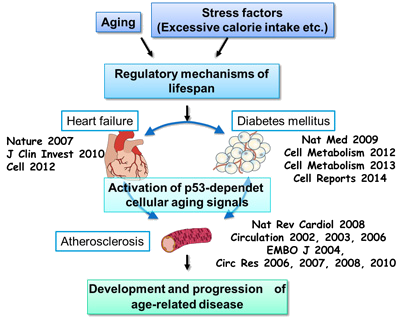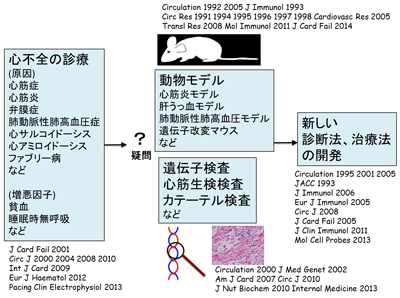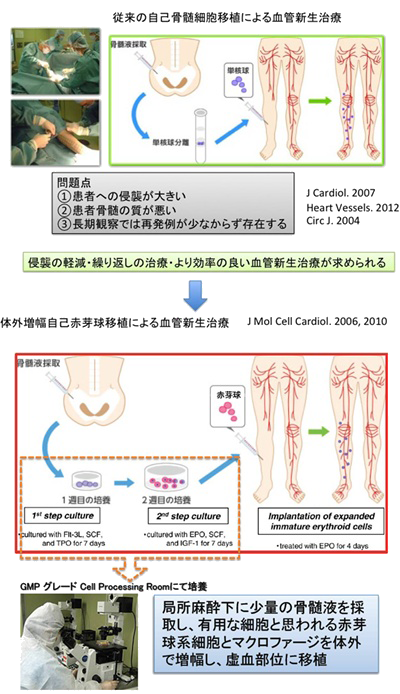1.Research Summary
The Department of Cardiovascular Medicine conducts basic and clinical research on arrhythmias, heart failure, and ischemic heart disease, as well as basic and clinical research aimed at the control of aging. In the areas of regenerative medicine and arrhythmias, we also promote translational research, in which basic data are applied to the clinical setting.
2.Research Groups
3-1.Aging Control Group
Research Subjects
3-2.Arrhythmia Group
Research Subjects
3-3.Heart Failure Group
Research Subjects
3-4.Ischemia and Regeneration Group
Research Subjects
Website of the Department of Cardiovascular Medicine
4.Research Results
[Area] Cardiovascular medicine (control of aging)
[Research subject]
Mechanisms of cardiovascular and metabolic aging
[Description]
The morbidity of lifestyle-related diseases, such as diabetes mellitus
and arteriosclerosis, increases with age. These diseases can be regarded
as comprising some of the traits of aging as they are commonly observed
in many elderly people. This means that the ultimate target for the treatment
of these diseases may be the longevity modulation mechanism itself.
Normal human somatic cells usually reach the state of cleavage arrest,
which is called replicative cell senescence, after a certain number of
proliferation cycles. The reported tissue accumulation of aged cells in
the elderly and significantly shortened
[Photographs]

lifetimes of cells obtained from patients with progeria syndrome indicate that the activation of cellular aging signals in tissues that occurs with aging may be involved in longevity and the pathophysiology of aging-related diseases. We have actually revealed that such cellular aging signals are activated in tissues (e.g., blood vessels, heart, and lipids) by aging and stress factors such as overeating, form an interactive network, and thereby become involved in the pathology of aging-related diseases. We will step up to the challenge of developing new therapies targeting these signals in the future.
[Area] Cardiovascular medicine (arrhythmias)
[Research subject]
Backgrounds and mechanisms of arrhythmias, and establishment of personalized medicine
[Description]
Sudden death is estimated to occur in 50,000 people annually in Japan,
and arrhythmias are the cause of sudden death in many cases. We provide
medical care for many arrhythmic cases and also conduct clinical research
aimed at elucidating the clinical characteristics of these cases and developing
new medications and advanced treatments.
Ongoing projects in our department will be described below. We perform
genetic testing for genes responsible for arrhythmia syndrome to elucidate
genetic causes and conduct searches for new responsible genes.
[Photographs]

In addition, we recently developed a new genetic screening assay based
on a next-generation sequencing method. J and T wave have been reported
to be associated with the occurrence of life-threatening ventricular arrhythmia.
We have investigated and reported the mechanisms of J, T wave and their
contribution to the occurrence and maintenance of arrhythmia using the
unique mapping system which can record the transmural electrocardiogram
from whole hearts. Ventricular fibrillation (VF) is the worst form of arrhythmia.
However, we have few methods for prevention of VF thus far. We conduct
the joint research with laboratories in the USA to develop the novel method
of catheter ablation for VF targeting the anatomical factors associated
with the induction and maintenance of VF. In the patients with atrial fibrillation
(AF), prevention of cardiogenic cerebral/systemic embolism is an important
clinical issue. Patients at adequate risk of cardiogenic cerebral/systemic
embolism are on anti-coagulation therapies with warfarin or direct oral
anticoagulants (DOAC). We evaluate the influence of physiological anti-coagulant
factor, inflammation, and aging on these anti-coagulation therapies. Moreover,
we are conducting a prospective multicenter study evaluating the efficacy
of AF ablation in the secondary prevention of cardiogenic cerebral/systemic
embolism. In basic research, we are planning to implement the optical mapping
system with the cutting edge high speed cameras and image processors to
image the activation pattern in atrium of (gene-modified) mice. The system
will enable us to investigate the mechanism of initiation/maintenance of
arrhythmias and correlation between its onset and aging/life style. Furthermore,
we are now planning to conduct a multicenter randomized controlled study
evaluating the efficacy of sodium glucose cotransporter (SGLT-2) inhibitor
in the secondary prevention of ventricular tachyarrhythmia in the patients
with implantable defibrillators.
The elucidated genetic and clinical information on and the mechanisms of
arrhythmias, as well as newly-developed therapies will be fed back into
clinical practice with the aim of establishing personalized therapies based
on background factors and the mechanisms responsible for arrhythmias. We
thus conduct “case-based bidirectional translational research,” in which
basic investigations are performed based on clinical information and the
results are then provided to our cases.
[Area] Cardiovascular medicine (heart failure)
[Research subject]
Etiologies of and factors precipitating heart failure
[Description]
The number of patients with heart failure is estimated to be 1,400,000
in Japan and is anticipated to increase even further in the future due
to the aging of society. Etiologies of heart failure include ischemic heart
disease, hypertension, cardiomyopathy, myocarditis, valvular disease, congenital
heart disease, arrhythmia, pericardial disease, and pulmonary arterial
hypertension, and a wide variety of factors precipitating heart failure,
such as anemia, sleep apnea, and renal failure, is known to exist. Therefore,
heart failure must be diagnosed and treated taking these various factors
into consideration.
[Photographs]

We conduct research to answer various questions that arise in clinical practice for heart failure through analyses and genetic diagnosis using animal models. As for the association of heart failure with immunity and inflammation, particularly, we have reported various findings. There has recently been an increasing recognition of the relevance of the association of heart failure with inflammation. It is considered likely that T cells, dendritic cells, macrophages, and cytokines, for instance, that are directly involved in inflammation, are not only engaged in injuries to the heart itself but also exert various effects on the whole body, being significantly involved in the etiologies of and the factors precipitating heart failure. Meanwhile, cases of cardiomyopathy due to genetic abnormalities have been successively revealed in recent years. We also aggressively perform genetic analyses to contribute to the elucidation of these disease entities and conduct research to achieve radical treatment in accordance with the etiologies of heart failure at our department. In addition, we hope to clarify various factors, including anemia and sleep apnea, which are involved in the exacerbation of heart failure and to study heart failure from a systemic standpoint in order to develop beneficial new therapies to be applied in clinical practice.
[Area] Cardiovascular medicine (ischemia and regeneration)
[Research subject]
Ex-vivo expanded erythroblast transplantation (autologous) (EVEETA study)
[Description]
“Angiogenesis therapy for severe lower limb ischemia by bone marrow mononuclear
cell implantation (BMI)” has been approved as advanced medical care at
our institution. As cases accumulated, however, it was revealed that only
a therapeutic effect lower than that observed in animal model studies can
be achieved for reasons such as the therapy being highly invasive for patients
and major difficulty collecting suitable bone marrow from patients.
We therefore planned to develop angiogenesis therapy employing ex-vivo
expanded erythroblast transplantation (autologous) as a new form of angiogenesis
therapy. Basic verification revealed that the bone marrow cells secreting
angiogenic factors, including VEGF and PDGF, are mainly erythroblasts,
in particular proerythroblasts and basophilic erythroblasts. We then initiated
the development of a method for obtaining these immature erythroblasts
in large amounts by ex vivo culture. It was consequently revealed that
large amounts of immature erythroblasts can be harvested in the following
manner: megakaryocyte-erythroid progenitor cells are amplified by a 7-day
culture (primary culture) in the presence of three types of hematopoietic
[Photographs]

factors, including EPO. An investigation using a mouse lower limb ischemia
model demonstrated that the angiogenic effect of this culture method was
10 times as potent as the therapeutic effect of the conventional method,
BMI.
We initiated the phase I/II study of ex-vivo expanded erythroblast transplantation (autologous)
(EVEETA study) after approval in May 2006 by the ethics committee and the institutional
review board established in our institution (ISRCTN66803682). We have treated
11 peripheral vascular disease patients with EVEETA therapy thus far and
have obtained very good results, including immediate relief and resolution
of leg pain, reduction in the sizes of refractory skin ulcers, and increases
in local tissue oxygen tension and skin perfusion pressure.
